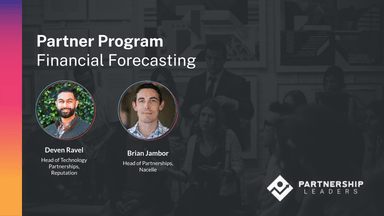The Value of OKRs for Improving Cross-functional Collaboration


The partnerships team must work closely with almost every other team in an organization in order to be successful. The strongest strategy I’ve found for getting an entire organization on the same page and working toward desired outcomes is setting company-wide objectives and key results (OKRs).
As a partnership leader with Ally.io (now a part of Microsoft Viva), I’ve had the privilege of learning the OKR methodology from top OKR consultants around the world. OKRs are a conduit for gaining initial buy-in and forging cross-departmental alignment; all in the name of getting from strategy to outcomes. Today, I’m digging into how setting OKRs improves cross-functional collaboration and the best practices for setting impactful OKRs.
The Value of Setting OKRs
There are three key benefit pillars associated with setting OKRs. The first is forging greater alignment. As a partnerships professional, I’m always trying to align with the executive team and other functions critical to our success.
Next, is providing transparency into everyone’s goals and associated efforts. If we’re aligned on our goals, ownership is clear, and dependencies are understood, we foster more meaningful conversation that is outcome-focused.
Finally, and perhaps most important, is the ability to focus on what’s most important. Even better than understanding what you’re working on is understanding what you’re not working on — it’s so easy to get distracted by various opportunities without this framework in place.
An OKR framework adopted at the company level gives everyone a clear sense of purpose and the opportunity to create impact. When partnership OKRs ladder up to company OKRs and are set and agreed to by all relevant stakeholders, your company has basically said, “We understand the value of partnerships, here’s our commitment to them.”
If our company didn’t have OKRs and wasn’t looking at the same scoreboard in Ally, we wouldn’t have the same relentless focus on the things that matter most; that focus put us at the top of our category and led to the acquisition by Microsoft Viva. Every week, our entire company looks at our instance of Ally and the status of the OKRs we set for the year.
Forging a Company-wide Investment in Growth
OKRs go beyond your partnership team. They’re a company-wide investment into leveling up your organization.
They need to be rolled out at the company level first, so they’re baked into your cultural DNA and business rhythms across all departments. There’s also an element of psychological safety that needs to be fostered in order to realize the full potential of OKRs; they are not about measuring individual performance or placing blame, they are the permission to drive growth, change, or innovation.
If you’re a partnership leader who wants to learn more about OKRs I highly recommend our free learning center.
Critical to organization-wide success is a shared understanding of two critical pieces:
First: What OKRs are, and what they’re not. This means having a clear definition as to why they’re being used and what the best practices you will be adhering to. Included in this are:
- Why OKRs are a relevant goal management methodology for your organization.
- How to write inspiring objectives.
- How to write effective key results.
- Translating strategy into annual/quarterly OKRs.
Second: How we will use OKRs and ensure their survivability. Included in this are:
- Establishing how OKRs will be rolled out organization-wide (planning, change management, communications, etc.).
- Creating a center of excellence with trained OKR coaches internally to foster progress.
- Integrating into existing rhythms of business and developing a process to write OKRs, present/adopt them, check-in, and do retrospectives.
Software alone isn’t the solution and OKRs are a complex organization-wide journey. In the early days, we brought on an OKR coach (shout out to There Be Giants) to help us refine our view on OKRs and align everyone on the points above. Having an objective third party navigate hard conversations related to the OKR journey is very helpful.
Best Practices for Setting Impactful OKRs
There isn’t one rule that fits all for implementing OKRs. Instead, it’s best to think of OKRs as a methodology and way of doing things. Each company, team, and individual brings their own perspective, culture, and way of doing things.
For example, you may be early to the OKR game and your senior leadership team wants to make sure a level understanding is set. In that situation, your leadership team may decide to set their own objectives and key results for Q1. Then, in the coming quarters, they’ll work with you and your team to develop objectives and key results that support those at the department level, and then have teams and individuals ladder up.
It depends on your organization’s strategy. Perhaps it doesn’t make sense for everyone to have OKRs and they stay at the department levels. But, the more actively involved you are in the OKR process, the better off you are to get all the benefits in terms of visibility and alignment.
In the early days, with under 25 employees, having dedicated OKR software may not make sense. What you’ll use is what 90% of the market uses — spreadsheets. However, at a certain point, spreadsheets don’t scale and can’t translate the intended benefits of OKRs to the organization.
When you want to realize the full potential of OKRs, whether you’re 25 employees or 25,000 employees, that’s when OKR software becomes really beneficial. It’s purpose-built for OKRs and structured in a way that’s easy to write, digest, and distribute across the organization.
Using a purpose-built platform also lets you take advantage of integrations to automate things. No one wants extra steps added to their day. An OKR platform uses integrations to ingest data from wherever you’re already working and populate your OKRs in the platform. This enables you to maintain a single source of truth that’s updated in real-time via data integrations with all of your existing platforms. Everyone across the organization can see how each department is tracking on their OKRs, what’s going well, and the challenges faced so you can have meaningful conversations at each check-in, all hands, and board meeting.
Improve Your OKRs with Insights from Other Partnership Leaders
As you’re getting started with OKRs, or even well into using OKRs, it can be helpful to explore examples from other professional organizations. That’s why I’ve worked to put together a collection of sample OKRs you can reference when building out your goals for the new year. You can download the resource here and submit your insights to be included in the next OKR guide via this form.
I’m a proud member of Partnership Leaders, where sharing partnership insights, strategies, and experiences is a core value. During my time as a member, I’ve learned a lot from other professionals and have been able to share my insights to help others. If you’re interested in connecting with me, you can find me on LinkedIn or apply to join Partnership Leaders.



